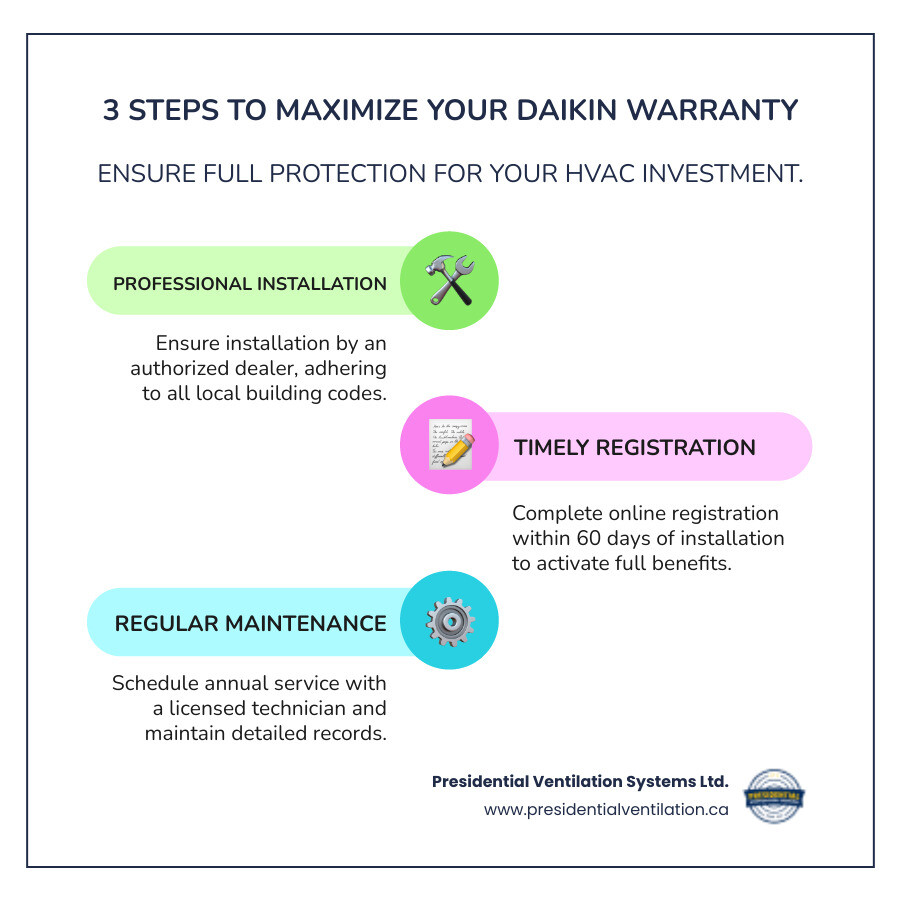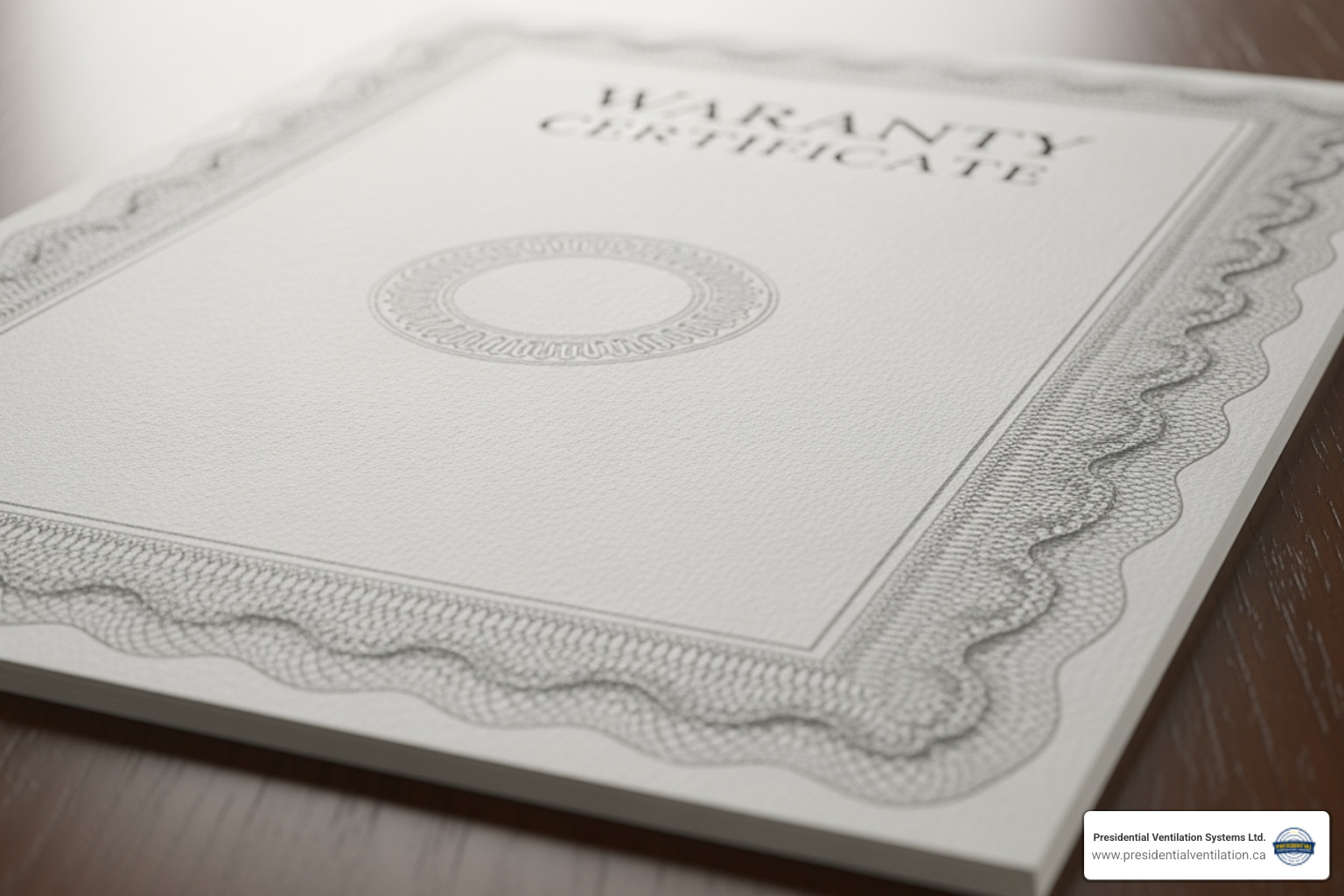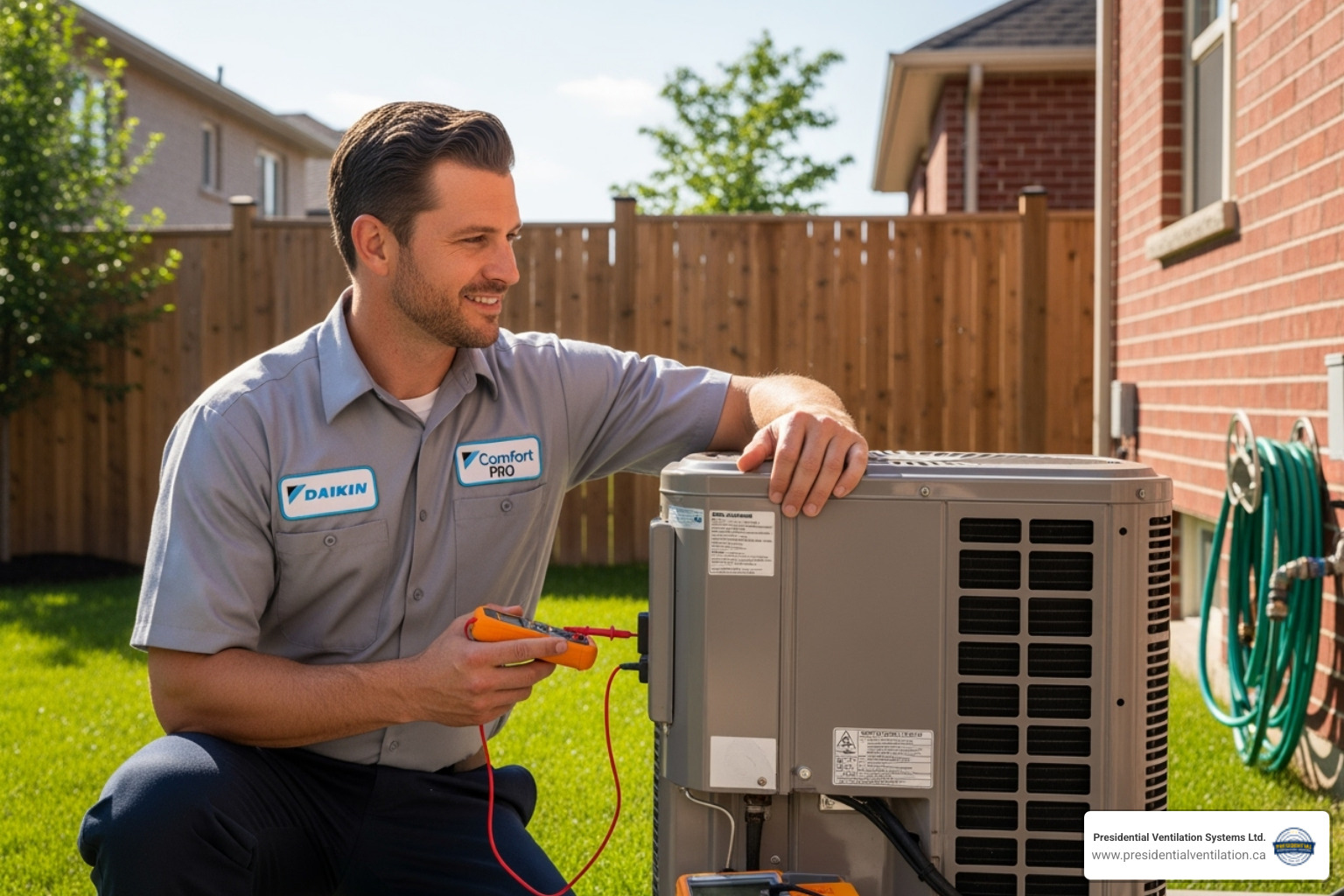Why Understanding Daikin Warranty Service Is Essential for Your HVAC Investment
Daikin warranty service provides comprehensive protection for your heating and cooling investment, but only if you understand how to properly activate and maintain your coverage. Here's what you need to know:
Quick Reference - Daikin Warranty Coverage:
- Parts Warranty: 5-12 years depending on product line
- Compressor Warranty: Up to 12 years for heat pumps and AC units
- Heat Exchanger: Lifetime warranty on gas furnaces
- Registration Deadline: 60 days from installation (required in most areas)
- Key Requirement: Professional installation by authorized dealer
When you invest thousands of dollars in a Daikin HVAC system, you're not just buying equipment - you're buying peace of mind. But here's the thing: many homeowners don't realize their warranty protection isn't automatic.
The reality is stark. Without proper registration within 60 days of installation, you could lose years of warranty coverage. Equipment purchased online and installed by unlicensed contractors? Your warranty is likely void before you even turn the system on.
Daikin offers some of the industry's most comprehensive warranty coverage, with parts warranties ranging from 5 to 12 years and lifetime heat exchanger coverage on furnaces. But this protection only works when you follow the rules.
The good news? Understanding and maximizing your Daikin warranty service is straightforward when you know what steps to take.

Understanding Your Daikin Warranty Coverage

When you invest in a Daikin HVAC system, you're getting more than just equipment - you're getting a promise. That promise comes in the form of comprehensive warranty coverage that protects your investment for years to come.
Think of your Daikin warranty as your safety net. It's the company's written guarantee that your system will perform as expected, and if something goes wrong due to manufacturing defects, they'll make it right. This commitment to quality is one reason Daikin has earned its reputation as the world's leading air conditioning manufacturer.
Daikin warranty service covers several key areas, each designed to protect different aspects of your system. Parts coverage forms the backbone of most warranties, protecting you against component failures for 5 to 12 years depending on your specific product. Your compressor - essentially your system's heart - gets special attention with coverage lasting up to 12 years on heat pumps and air conditioners.
For certain models, Daikin goes even further with unit replacement warranty. If your compressor fails under specific conditions (like being properly matched with a new indoor coil), they might replace your entire outdoor unit at no charge. That's not just fixing a problem - that's giving you a fresh start.
Gas furnace owners get something truly special: a lifetime heat exchanger warranty. As long as you own your home, if that critical component fails, Daikin replaces the entire unit. It's the kind of coverage that lets you sleep soundly knowing your family's comfort is protected.
For complete details about your specific product's coverage, Daikin's Owner Support Center provides comprehensive warranty information custom to your exact model.
Warranty Durations by Product Line
Different Daikin products come with different levels of protection, and understanding what your specific system offers helps you make the most of your coverage.
Single-zone systems - perfect for targeting specific areas of your home - come with a solid 10-year parts limited warranty. These systems are popular for additions, workshops, or rooms that need extra attention.
Multi-zone systems step things up with a 12-year parts limited warranty. Since these systems handle multiple areas of your home independently, the extended coverage makes sense. You're managing more complexity, so you get more protection.
Daikin heat pumps also enjoy that robust 12-year parts coverage, with many models qualifying for additional unit replacement protection. Whether you're considering a traditional heat pump or something innovative like the Daikin Fit, you're looking at industry-leading warranty protection.
Gas furnaces combine that impressive 12-year parts warranty with the lifetime heat exchanger coverage we mentioned earlier. Some models even include unit replacement warranties, giving you multiple layers of protection.
Even the smaller components get attention. Thermostats and controls receive 12-year parts coverage, while air quality products like air cleaners typically come with 5-year parts warranties plus 1-year unit replacement coverage.
Here's the catch that many homeowners miss: most of these extended warranty periods require online registration within 60 days of installation. Skip this step, and you could lose years of valuable coverage.
Residential vs. Commercial Applications
Daikin recognizes that a cozy family home and a busy office building have very different needs, and their warranty structure reflects this reality.
Residential systems get the royal treatment with longer warranty periods and more comprehensive coverage. That lifetime heat exchanger warranty? It's designed specifically for owner-occupied residences where families plan to stay put for years. The 10 to 12-year parts warranties also reflect typical home usage patterns.
Commercial applications face a different reality. These systems work harder, run longer hours, and deal with more demanding conditions. Because of these different usage demands, commercial warranties typically have shorter terms. A restaurant's HVAC system simply can't be expected to have the same lifespan as your home's system when it's running 12 hours a day, seven days a week.
The distinction between owner-occupied and non-owner occupied properties also matters. Rental properties or vacation homes may have different registration requirements or transferability rules, especially in certain regions.
If you're a business owner exploring commercial options, our Daikin Commercial Heat Pumps Guide provides insights into what commercial-grade Daikin systems can offer your business.
Understanding these differences helps ensure you get the right system with appropriate warranty coverage for your specific situation. Whether you're heating your family home or cooling your business, Daikin has structured their warranties to match real-world usage patterns.
How to Activate and Maintain Your Warranty
Your Daikin warranty service isn't something you can just tuck away in a drawer and forget about. Think of it more like a partnership - one where you have some important responsibilities to keep everything running smoothly. The good news? These steps are pretty straightforward once you know what's expected.
The key to keeping your warranty valid comes down to three main things: getting your system installed properly, registering it on time, and keeping up with regular maintenance. Miss any of these, and you could find yourself facing expensive repairs that should have been covered. For a broader look at heat pump warranty basics, check out our page on Warranty on Heat Pump.
The Critical 60-Day Registration Window
Here's where many homeowners accidentally shoot themselves in the foot - and it's completely avoidable. Most Daikin products require online registration within 60 days of installation to open up their full warranty benefits.
Let me put this in perspective. Skip this simple online registration, and your impressive 10-year or 12-year parts warranty might shrink down to just 5 years. That's potentially 7 years of protection lost because nobody filled out a form that takes about 10 minutes to complete.
Why does Daikin care so much about registration? It helps them keep track of when and where their systems are installed, which makes the whole warranty claims process much smoother down the road. Plus, it confirms that your system was actually installed within a reasonable time after purchase.
Now, there are a few places where the rules are a bit different. In California, Florida, and Quebec, consumer protection laws mean your warranty coverage can't be cancelled just because you forgot to register. But even in these areas, registering is still your best bet for keeping everything organized.
Don't let this slip through the cracks. Make sure to Register Your Product as soon as your new system is up and running.
Professional Installation and Regular Maintenance
Your warranty has two non-negotiable requirements that you absolutely cannot skip: professional installation by a licensed contractor and annual maintenance by a qualified technician.
Let's start with installation. Daikin is crystal clear about this - if your system isn't installed by properly licensed professionals following all local codes and regulations, your warranty is void. Period. This means certified HVAC installers for the main system, licensed plumbers for any gas or water connections, and licensed electricians for electrical work.
This isn't Daikin being difficult - it's about safety and performance. We've seen too many DIY disasters and unlicensed installations that create safety hazards, waste energy, and break down prematurely. None of that damage gets covered under warranty.
The second pillar is regular professional maintenance. Your warranty typically requires annual service by a licensed HVAC contractor. This isn't just a suggestion - it's mandatory for maintaining coverage, especially for unit replacement and lifetime heat exchanger warranties.
During these annual visits, technicians clean coils, check refrigerant levels, inspect electrical components, and catch small problems before they become expensive headaches. While you can handle basic tasks like changing filters, professional maintenance goes much deeper. Our Heat Pump Services Products are designed to keep your system running at peak performance.
Keep detailed records of all service work. Save every receipt and maintenance report. These documents are your proof that you've held up your end of the warranty agreement. Without them, a warranty claim might get denied even if everything else was done correctly.
The Risk of "Internet Sales" and Your Daikin Warranty Service
Online shopping is great for many things, but HVAC equipment? That's where things get tricky - especially when it comes to protecting your Daikin warranty service.
Here's the reality: buying Daikin equipment online often voids your warranty, even if the unit is brand new. Daikin's policy is straightforward - warranty coverage requires installation by licensed professionals following all applicable codes and regulations. Buy online and use an unlicensed installer? Your warranty protection disappears.
Why is Daikin so strict about this? HVAC systems are complex beasts that need proper sizing, careful handling of refrigerants, and precise electrical connections. When unlicensed contractors cut corners, bad things happen.
Safety becomes a real concern with improper installation. We're talking about potential fire hazards from bad electrical work and environmental damage from refrigerant leaks. Your system won't run efficiently either, which means higher energy bills and less comfort - the exact opposite of what you wanted from a high-quality Daikin unit.
Poor installation also puts unnecessary stress on components, leading to early failures that won't be covered under warranty. What looked like a money-saving move upfront becomes an expensive nightmare later.
Daikin wants their excellent equipment (and there are many reasons Why Daikin is a top choice) installed correctly so it can deliver the performance and longevity it was designed for. We've helped too many homeowners deal with the headaches of improperly installed systems. Trust us - the short-term savings aren't worth the long-term problems.
Your Guide to the Daikin Warranty Service and Claims Process

Even the most reliable Daikin systems can occasionally hiccup – it's just the nature of mechanical equipment. When issues arise, knowing how to steer the Daikin warranty service and claims process can save you both time and stress. Think of it like knowing the quickest route to the hospital – you hope you'll never need it, but you'll be grateful you know the way if you do.
The good news? If you've been following along with our advice on proper installation, timely registration, and regular maintenance, filing a warranty claim should be relatively straightforward. Your authorized dealer becomes your advocate in this process, handling the heavy lifting while you focus on getting your comfort back.
Before you pick up the phone, take a moment to gather some basic information. What exactly is happening with your system? Is it making strange noises, not heating or cooling properly, or displaying error codes? Sometimes a quick check of your thermostat settings or air filter can resolve simple issues. But when it's clearly a system problem, don't delay – prompt action is key to a smooth claims process.
Step-by-Step: Filing a Warranty Claim
Filing a warranty claim doesn't have to feel like navigating a maze. Here's exactly how the process works when you partner with an authorized Daikin dealer:
1. Identify the issue as specifically as possible. Note any unusual sounds, smells, or performance problems. If your system is displaying error codes, write them down. The more details you can provide, the faster your dealer can help.
2. Contact your authorized dealer immediately – not Daikin directly. Your dealer is your first line of support and has the expertise to handle your claim efficiently. For homeowners across Nova Scotia, including Halifax, Truro, Kentville, and surrounding areas, Presidential Ventilation Systems Ltd. is ready to spring into action.
3. Provide model and serial numbers along with your installation date. You'll find this information on labels attached to your indoor and outdoor units, or in your original installation paperwork. Having these details ready speeds up the entire process.
4. Dealer diagnoses the problem and handles the claim with Daikin completely. Once they've identified a warranty-covered issue, your dealer manages all the paperwork, orders replacement parts directly from Daikin, and schedules your repair. You get to sit back while they handle the logistics.
Why a Daikin Comfort Pro Dealer is Your Best Ally
Working with a Daikin Comfort Pro Dealer like Presidential Ventilation Systems Ltd. isn't just convenient – it's your secret weapon for seamless Daikin warranty service. These aren't your average HVAC contractors; they're part of an elite group that has earned Daikin's stamp of approval through rigorous training and proven excellence.
Expert training sets Comfort Pro Dealers apart from the competition. Their technicians receive ongoing, specialized education directly from Daikin, making them true system specialists. They understand the intricate details of Daikin technology, from installation nuances to advanced troubleshooting techniques. When they diagnose your system, you can trust their expertise.
The streamlined claims process becomes effortless when you work with a Comfort Pro Dealer. They speak Daikin's language fluently, meaning faster claim processing and fewer communication hiccups. While other contractors might struggle with warranty paperwork, your Comfort Pro Dealer handles everything professionally and efficiently.
Correct installation and maintenance from day one protects your warranty investment. Comfort Pro Dealers guarantee that your system meets Daikin's exact specifications and all local building codes. They also provide the annual maintenance that keeps your warranty valid and your system running at peak performance.
Their in-depth product knowledge extends beyond repairs to optimization advice, feature explanations, and guidance on extended warranty options. When you choose a Daikin Comfort Pro Dealer Halifax NS, you're not just getting a service provider – you're gaining a long-term partner invested in your comfort and satisfaction.
Common Warranty Limitations and Exclusions
Understanding what your Daikin warranty doesn't cover is just as important as knowing what it does. Think of it like reading the fine print on any important agreement – a few minutes of clarity now can prevent big surprises later.
Labor costs represent the most significant limitation that catches homeowners off guard. While Daikin covers the replacement parts under warranty, the labor to diagnose problems and install new components typically falls to you. It's like getting free replacement ingredients for a recipe, but still paying the chef to cook the meal.
Routine maintenance items such as annual tune-ups, coil cleaning, and system inspections remain your responsibility. These services are essential for maintaining warranty validity, but they're considered normal homeowner obligations rather than warranty-covered repairs.
Consumables like filters, humidifier pads, and UV lamps need regular replacement by design. Since these items are meant to be changed routinely, warranty coverage doesn't extend to them. It's similar to how your car warranty doesn't cover oil changes or windshield wipers.
Damage from misuse or neglect can void your warranty coverage entirely. This includes skipping annual maintenance, unauthorized repairs, improper operation, or installation by unqualified personnel. The lesson? Stick to the rules, and your warranty will stick with you.
Acts of God and external factors like floods, lightning strikes, power surges, or vandalism fall outside warranty protection. These situations are typically covered by your homeowner's insurance instead. Your HVAC warranty focuses on manufacturing defects and component failures under normal operating conditions.
Extending Your Coverage with the Asure Extended Service Plan

Picture this: it's the middle of a Nova Scotia winter, and your heat pump suddenly stops working. Under Daikin's standard warranty, the replacement part might be covered, but you're still looking at potentially hundreds of dollars in labor costs to get your system back up and running. This is where the Daikin warranty service gets even better with the Asure Extended Service Plan.
Think of the Asure plan as your financial safety net for those "what if" moments. While Daikin's standard warranties provide excellent protection for parts and major components, they typically leave you responsible for labor costs when repairs are needed. The Asure Extended Service Plan fills this gap beautifully, offering comprehensive coverage that includes both parts and labor.
This extended protection transforms unpredictable repair expenses into manageable, budgeted costs. For homeowners who plan to enjoy their comfortable homes for years to come, it's like having a maintenance fund that's already paid for and ready when you need it most.
What the Asure Plan Covers
The beauty of the Asure Extended Service Plan lies in its flexibility and comprehensive approach. You can choose between a 6-year option or a 12-year option, depending on how long you want that extra layer of protection.
Here's what makes this plan so valuable: unexpected repair costs become a thing of the past. When your Daikin system needs service, the plan steps in to handle both sides of the repair equation.
The covered parts aspect extends your protection beyond what the standard warranty offers. This means more components are potentially covered, giving you broader protection across your entire system. But here's the real game-changer – covered labor expenses. This is where the Asure plan truly shines and sets itself apart from standard manufacturer warranties.
Labor costs can easily run into the hundreds or even thousands of dollars over your system's lifetime. With the Asure plan, those diagnostic fees, installation time, and repair work are covered for qualifying service calls. It's the difference between getting a bill for $50 versus $500 when something goes wrong.
The plan is exclusively available through Authorized Asure Dealers, ensuring that any service you receive meets the high standards you expect. For complete details about coverage specifics and terms, the Asure Extended Warranty Brochure provides all the information you need to make an informed decision.
Is an Extended Daikin Warranty Service Plan Right for You?
Deciding on an extended Daikin warranty service plan comes down to your comfort level with financial surprises and your long-term plans for your home. Let's be honest – HVAC systems don't usually break down at convenient times, and repair bills never seem to arrive when your budget is feeling flush.
Comprehensive protection is the cornerstone benefit. You're covered for both the parts that might fail and the skilled technicians needed to fix them. This dual coverage can save you significant money over the years, especially as your system ages and components naturally wear out.
The worry-free comfort aspect is perhaps even more valuable than the financial protection. There's something deeply satisfying about knowing that when your system needs attention, you can simply call your authorized dealer without mentally calculating repair costs. You can focus on staying comfortable rather than stressing about your wallet.
Fixed costs make budgeting so much easier. Instead of setting aside money each month hoping it'll be enough for potential repairs, you pay a predictable amount upfront. Daikin describes this as costing "pennies a day" on average – a small daily investment that can prevent major financial headaches down the road.
Many extended service plans offer transferability options, which can actually add value to your home if you decide to sell. Imagine being able to tell potential buyers that your HVAC system comes with years of remaining warranty coverage. That's a selling point that sets your home apart.
Most importantly, there's the peace of mind factor. Your Daikin system is a significant investment in your family's comfort. An extended warranty plan protects that investment and ensures you can enjoy consistent, reliable heating and cooling without financial worry.
For homeowners planning to stay put for several years, an extended Daikin warranty service plan often proves to be one of those "glad I did it" decisions. It transforms your HVAC system from a potential source of financial stress into a reliable, protected comfort solution for your home.
Conclusion: Secure Your Comfort with Daikin and a Trusted Partner
Understanding your Daikin warranty service doesn't have to feel like deciphering a legal document. As we've walked through together, it's really about building a foundation of protection for one of your home's most important investments. Think of it like tending a garden - with the right care and attention, your HVAC system will flourish for years to come.
Daikin's strong warranty commitment speaks volumes about their confidence in their products. When a company offers 12-year parts coverage and lifetime heat exchanger warranties, they're putting their money where their mouth is. But here's the thing - this protection works best when it's a partnership between you, Daikin, and your trusted dealer.
The path to maximizing your investment is refreshingly straightforward. Register your product within those crucial 60 days - it's like claiming your golden ticket to extended coverage. Choose professional installation from a licensed, authorized dealer because cutting corners here is like building a house on sand. Keep up with annual maintenance and document everything - your future self will thank you when a claim goes smoothly instead of hitting roadblocks.
We've seen too many homeowners learn the hard way about online equipment purchases. That "deal" often becomes expensive when warranty protection vanishes. It's like buying a parachute from someone who's never jumped - the savings aren't worth the risk.
Partnering with a Daikin Comfort Pro Dealer transforms what could be a stressful experience into a smooth journey. We handle the technical details, streamline warranty claims, and ensure your system gets the expert care it deserves. When something goes wrong (and eventually, something always does), you'll have a knowledgeable ally in your corner.
For those seeking ultimate peace of mind, an Asure Extended Service Plan bridges the gap between standard warranty coverage and complete protection. It's like having both an umbrella and a raincoat - you're covered no matter what the weather brings.
At Presidential Ventilation Systems Ltd., we've been helping Nova Scotia families stay comfortable for over 30 years. From Halifax to Kentville, Truro to Windsor, we've seen how proper installation, timely registration, and regular maintenance transform a good HVAC system into a great long-term investment. As a leading Daikin Comfort Pro Dealer, we're not just selling equipment - we're building lasting relationships based on trust, expertise, and exceptional service.
Your comfort shouldn't be left to chance. With Daikin's exceptional warranty program and the right professional partner, you can enjoy reliable heating and cooling for decades to come.
Schedule Your Heat Pump Maintenance in Halifax